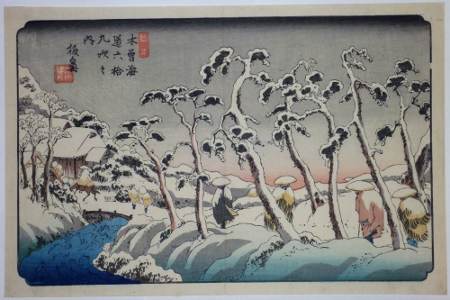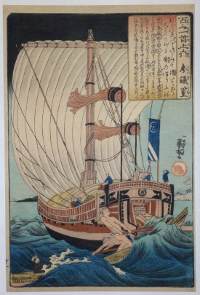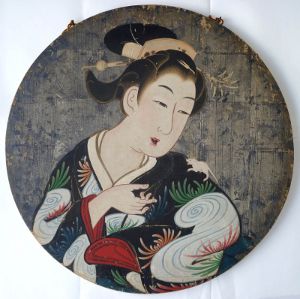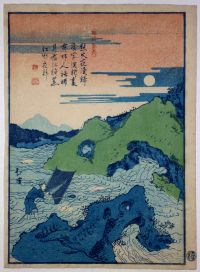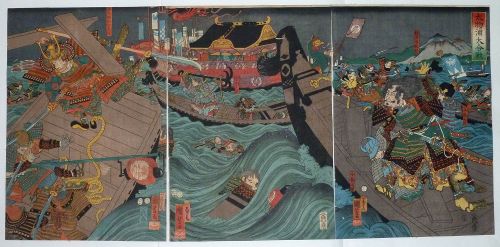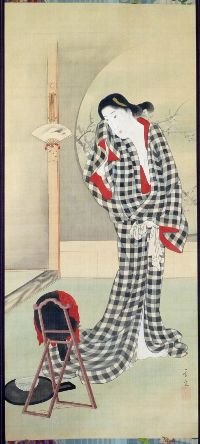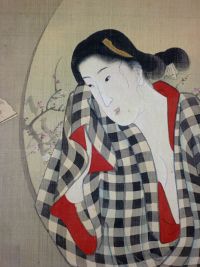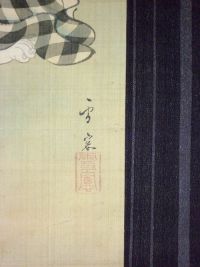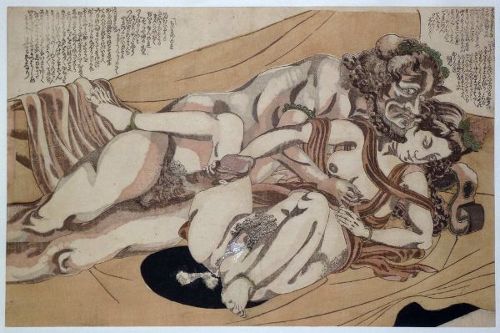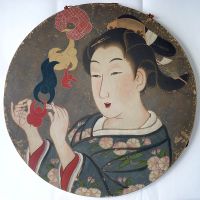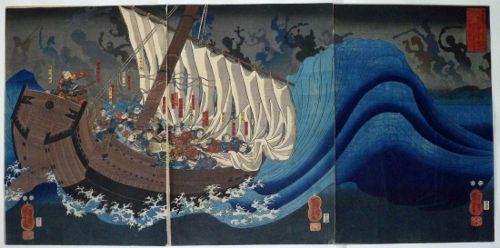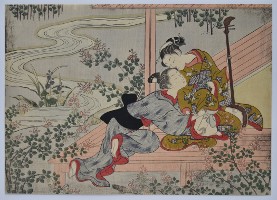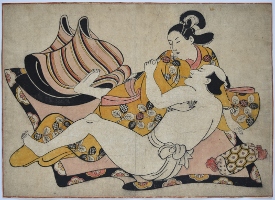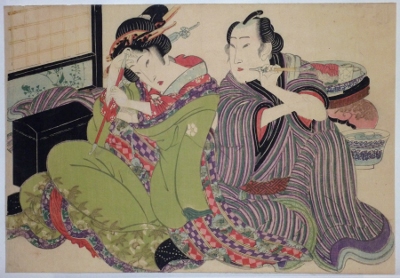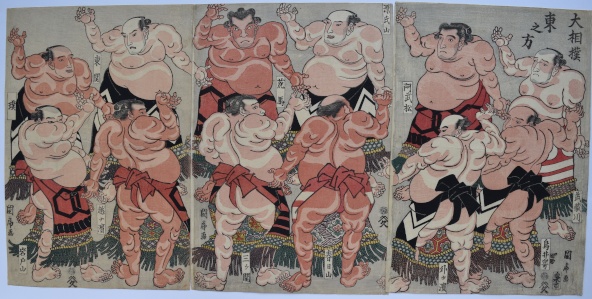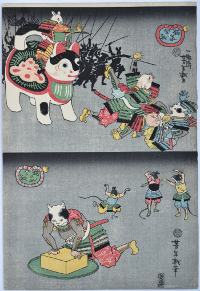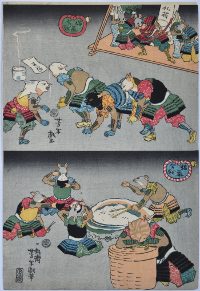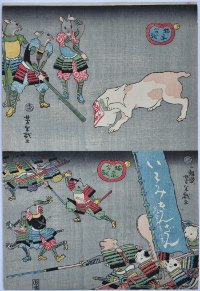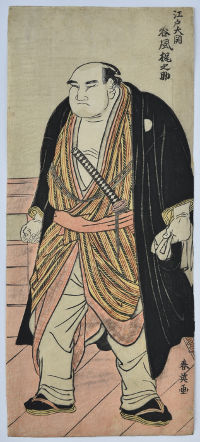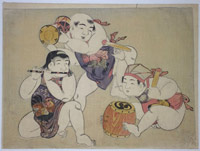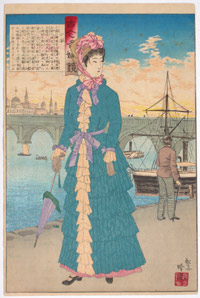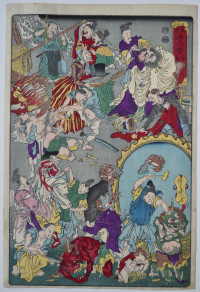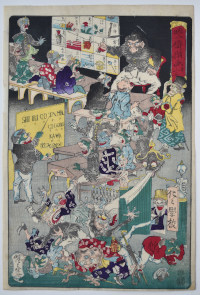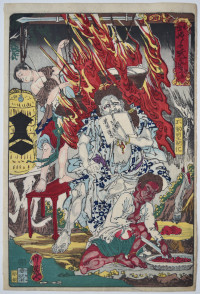Keisai EISEN (1790-1848)
Click here to view image full size.
Itahana from Kisokaido rokujukyutsugi no uchi, “Sixty-Nine Stations of the Kisokaido.” The set of seventy prints was started by Eisen and published by Hoeido in 1835, but in 1837 Hiroshige took over and completed the series with the publisher Iseya Rihei (Kinjudo). One of the best designs from the set. This design is never signed, even, as here, on the first edition. Rare.
Fine impression and colour. This is the first edition with gradation on the river and the river bank. Slight centre fold, otherwise fine condition. Ex Pulverer collection and purchased from me in 1974.
Status: Sold
Utagawa KUNIYOSHI (1797-1861)
Click here to view image full size.
The stern of a large sailing-junk and a smaller vessel infront. A poem by Sangi Takamura (Ono no Takamura) from Hyaku-nin isshu, “The Hundred Poets” published by Ebine c 1838. Depending which story one reads, either Takamura, who was a customs official for ships trading to and from China, went missing on a mission or was reported for being an extortioner and banished to the Oki Islands. Either way, he was subsequently pardoned. One of the best designs from this fine set. Robinson S19.11 and illustrated in Robinson (1961), no. 59.
Fine impression. Very good colour. Remargined top and bottom, otherwise very good condition. Signed Ichiyusai Kuniyoshi ga.
Status: Sold
Tsukioka SETTEI (1710-1786)
Click here to view image full size.
An interesting large painting, full colour on paper mounted on a wooden frame, 25.5 in; 62cms in diameter showing a bust portrait of a beauty with elaborate coiffure and a white mouse. Although not signed, the attribution is unquestionable, painted between 1767-1773 in Osaka. It appears to have been commissioned to hang in a hairdresser’s or cosmetic shop and has metal eyes at the top. The oxidised silver leaf background was meant to resemble a mirror and the idea of busts reflected in mirrors and silver grounds was later employed by Utamaro and Sharaku. Besides silver, gum and raised painting is applied. Such signboards appear in an illustrated book by Hasegawa Mitsunobu published in Osaka in 1752. This new discovery has been written about by Dr. Yamamoto Yukari in vol.27 of Minzoku Geijutsu (Ethno-Arts) in 2011. Minor surface marks all over but astonishingly good condition given their age and use. Extremely rare.
Status: Sold
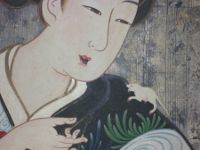
Click here to view image full size.
Totoya HOKKEI (1780-1850)
Click here to view image full size.
A fisherman with a scoop and net seemingly trying to catch the moon’s reflection. One of an excessively rare chuban series with title Toshi gafu no uchi, “Drawing Album for Chinese Poems” printed in red, and sub-title Toshin denshi. Printed in tones of blue except for a light flush on the horizon. Another impression ( trimmed ) was in the Vever collection ( ex Hayashi ), Sotheby’s, Part III, lot 295. Other impressions ( damaged ) are in the BM, ref: 1937, 0710,0,230 and Honolulu Museum of Art, ref: 14463. Hokkei was one of Hokusai’s best pupils and designed many fine surimono.
Fine impression, colour and condition. Signed Hokkei.
Status: Sold
Utagawa KUNIYOSHI (1797-1861)
Click here to view image full size.
Daimotsu-no-ura o-kassen. A triptych showing the battle of Dan-no-ura. The clash between the Minamoto (Genji) clans and the Heike (Taira) clans happened in 24/3/1185 when the Taira were defeated by Yoshitsune. He is shown here on the left making his leap pursued by Noritsune. The Imperial barge is in the background. Published by Moriya Jihei, 1856. Robinson T337.
Fine impression and colour. Slight trimming, otherwise very good condition. Signed Ichiyusai Kuniyoshi ga.
Status: Sold
Utagawa YOSHIHIDE (1832-1902)
Click here to view image full size.
A painting in full colour on silk, 33.75 x 14.4 in; 85.6 x 36.6 cms. Shows a beauty after a bath looking down at her mirror. Yoshihide was a pupil of Kuniyoshi. In extremely good condition. Signed and sealed Sesso. Inscription guarantee on inside of box: “Late February in the 56th Year of the Showa era (1981).” Appraised, signed and sealed by Mr Tosuke Kimura.
Status: Sold
Yanagawa SHIGENOBU (1787-1832)
Click here to view image full size.
A European couple in flagrante from a set Yanagi no arashi, “Storm of Willows” published c 1832. This highly unusual shunga print with chiaroscuro modelling is obviously based on imported woodcuts and engravings from Europe. There also exist several other shunga prints showing Dutchmen. See Shunga sex and pleasure in Japanese art, Timothy Clark et al, BM, 2013, no 120, p. 402.
Very good impression, colour and condition. Mica applied to the vulva. The set is unsigned but generally accepted as being by Shigenobu.
Status: Sold
Tsukioka SETTEI (1710-1786)
Click here to view image full size.
An interesting large painting, full colour on paper mounted on a wooden frame, 25.5 in; 62cms in diameter showing a bust portrait of a beauty with elaborate coiffure hanging paper acrobats. Although not signed, the attribution is unquestionable, painted between 1767-1773 in Osaka. It appears to have been commissioned to hang in a hairdresser’s or cosmetic shop and has metal eyes at the top. The oxidised silver leaf background was meant to resemble a mirror and the idea of busts reflected in mirrors and silver grounds was later employed by Utamaro and Sharaku. Besides silver, gum and raised painting is applied. Such signboards appear in an illustrated book by Hasegawa Mitsunobu published in Osaka in 1752. This new discovery has been written about by Dr. Yamamoto Yukari in vol.27 of Minzoku Geijutsu (Ethno-Arts) in 2011. Minor surface marks all over but astonishingly good condition given their age and use. Extremely rare.
Status: Sold
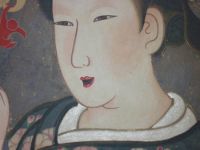
Click here to view image full size.
Utagawa KUNIYOSHI (1797-1861)
Click here to view image full size.
A triptych showing the ghosts of the Taira (Heike) warriors attempting to sink Yoshitsune’s ship off the coast of Settsu on his way to Shikoku. This is one of Kuniyoshi’s great designs – amongst the three or four best triptychs and is illustrated in numerous publications. The scene is the outcome of a great battle at Dan-no-ura where the Minamoto (Genji) clans clashed and defeated the Taira clans a few years earlier. The spirits of the drowned warriors rose up to seek revenge only to be pacified by Benkei reciting exorcisms with his rosary. Published 1849-52 by Enshuya Hikobei. Robinson T242. Rare.
Very good impression and colour although slightly mismatched blue on the first and second sheets. Very good condition. Full size. There appear to be three states of this design: The main difference being in the shape of the ghosts and lines in the waves only on the first state. In this (the second state) the ghosts lack some of the features that are on the first and a large spirit appears above the wave over the ship on the centre panel. The third state has further differences in the ghosts and lacks this figure. Also, the colour of the boat gets greyer. Signed Ichiyusai Kuniyoshi ga.
Status: Sold
Terasawa MASATSUGU (active c 1760-1790)
Click here to view image full size.

Click here to view image full size.
An original two-sided sumi block for printing pages 21, 22, 23, and 24 for the shunga book Aya no odamaki, “A Twist of Figured Cloth.” (See Sex and the Floating World, Timoin Screech, BM, 1999, p. 32-33.) The book was published in 1776. Also illustrated and described in Eiri Shunga Ehon Mokuroku, Tokyo 2007, p. 79. Extremely rare. Sold “as is” with imperfections (mostly wormage). See my blog.
Status: Sold
Terasawa MASATSUGU (active c 1760-1790)
Click here to view image full size.

Click here to view image full size.
An original two-sided sumi block for printing pages 9, 20, 18, and 19 for the shunga book Aya no odamaki, “A Twist of Figured Cloth.” (See Sex and the Floating World, Timoin Screech, BM, 1999, p. 32-33.) The book was published in 1776. Also illustrated and described in Eiri Shunga Ehon Mokuroku, Tokyo 2007, p. 79. Extremely rare. Sold “as is” with imperfections (mostly wormage). See my blog.
Status: Sold
Terasawa MASATSUGU (active c 1760-1790)
Click here to view image full size.

Click here to view image full size.
An original two-sided sumi block for printing pages 14, 15, 16, and 17 for the shunga book Aya no odamaki, “A Twist of Figured Cloth.” (See Sex and the Floating World, Timoin Screech, BM, 1999, p. 32-33.) The book was published in 1776. Also illustrated and described in Eiri Shunga Ehon Mokuroku, Tokyo 2007, p. 79. Extremely rare. Sold “as is” with imperfections (mostly wormage). See my blog.
Status: Sold
Terasawa MASATSUGU (active c 1760-1790)
Click here to view image full size.

Click here to view image full size.
An original two-sided sumi block for printing pages 10, 11, 12 and 13 for the shunga book Aya no odamaki, “A Twist of Figured Cloth.” (See Sex and the Floating World, Timoin Screech, BM, 1999, p. 32-33.) The book was published in 1776. Also illustrated and described in Eiri Shunga Ehon Mokuroku, Tokyo 2007, p. 79. Extremely rare. Sold “as is” with imperfections (mostly wormage). See my blog.
Status: Sold
Terasawa MASATSUGU (active c 1760-1790)
Click here to view image full size.

Click here to view image full size.
An original two-sided sumi block for printing pages 5, 6, 7, and 8 for the shunga book Aya no odamaki, “A Twist of Figured Cloth.” (See Sex and the Floating World, Timoin Screech, BM, 1999, p. 32-33.) The book was published in 1776. Also illustrated and described in Eiri Shunga Ehon Mokuroku, Tokyo 2007, p. 79. Extremely rare. Sold “as is” with imperfections (mostly wormage). See my blog.
Status: Sold
Terasawa MASATSUGU (active c 1760-1790)
Click here to view image full size.

Click here to view image full size.
An original two-sided sumi block for printing pages 1, 2, 3, and 4 for the shunga book Aya no odamaki, “A Twist of Figured Cloth.” (See Sex and the Floating World, Timoin Screech, BM, 1999, p. 32-33.) The book was published in 1776. Also illustrated and described in Eiri Shunga Ehon Mokuroku, Tokyo 2007, p. 79. Extremely rare. Sold “as is” with imperfections (mostly wormage). See my blog.
Status: Sold
Suzuki HARUNOBU (1724-1770)
Click here to view image full size.
A wonderful chuban shunga print showing a young suitor leaning across an engawa and interrupting a beauty playing a shamisen by partially lifting her robe. They are surrounded by flowering bushes and a meandering stream. A rare design I cannot, at the moment, locate being illustrated. Published c. late 1760s.
Very fine impression on thick hosho. Extremely fine colour. Slight oxidation, otherwise fine condition.
Status: Sold
Katsushika HOKUSAI (1760-1849)

Click here to view image full size.
A matron with lover. A shunga sheet from the extremely rare de-luxe edition of the Fukujuso, “The Adonis Plant.” The blocks were re-carved, the text deleted, a mica ground added, and sumptuous hand-colouring applied and was renamed Nami chidori, “Plovers Above the Waves.” This was a costly exercise and was obviously directed at a few wealthy clients. Hokusai’s best shunga set with large figures often completely filling the space. Published c 1820. Another example illustrated in Richard Lane, Hokusai, Life And Work, Barrie & Jenkins, 1989, no. 224, p. 168.
Fine impression. Wonderful fresh carefully hand-applied colour with mica ground. Album backing. Centre fold (as usual) and slight soil to corner. But otherwise very good condition.
Status: Sold
Torii KIYONOBU I (1664-1729)

Click here to view image full size.
A large sumi oban showing a couple in flagrante. These prints were normally issued in sets of twelve and would only have had the signature on the first sheet. Published c 1704-1711. Provenance: Ex Kiyoshi Shibui collection.
Very good impression. Slight edge soil and centre fold with small pin holes, but generally good condition considering the age.
Status: Sold
Suzuki HARUNOBU (1724-1770)

Click here to view image full size.
A chuban shunga print showing the occupant of a kago in flagrante with one of the porters, having seized the opportunity of a stop on the journey. Published late 1760s. Rare.
Very fine impression on thick hosho: The outlines raised in certain areas. Fine colour and condition.
Status: Sold
Suzuki HARUNOBU (1724-1770)

Click here to view image full size.
A couple in flagrante on an open engawa which has a large bowl of goldfish. There were many attempts by the Tokugawa Shogunate (1603-1868) to suppress shunga with edicts issued in 1661, 1722 and the 1790s. None of these were particularly effective and production usually resumed with most Ukiyo-e artists producing shunga prints, books or paintings. Published c. 1768. Unsigned as often with these shunga prints.
Superb impression. Fine, unfaded colour. Fine condition.
Status: Sold
Okumura MASANOBU (1686-1764)

Click here to view image full size.
The Fourth Month, Shibumukute toshimano mumami jukushi kaki, “Well Aged and Ripe Persimmon” from a set of 12 shunga prints Someiro no yama, Neya no hinagata, “Mountains of Dyed Colours, Patterns for the Bedroom.” One of the finest shunga sets; of large size and beautifully hand coloured. Published c. 1740. Others from the set are illustrated in Tim Clark, Shunga: Sex and Pleasure in Japanese Art, BM, 2013, p. 147-151. Masanobu is one of the most important figures in Ukiyo-e being the proprietor of a shop but also a publisher, an illustrator of books, print publisher, painter, and inventor of the hashira-e and uki-e as well as being at the forefront of advancements in colour printing. Rare.
Very good impression, colour and condition.
Status: Sold
Okumura MASANOBU (1686-1764)

Click here to view image full size.
The fifth month from a set of twelve prints Someiro no yama: Neya no hinagata, “Mountains of Dyed Colours: Patterns for the Bedroom.” A haiku poem relating to the time of year on each design. Published c. 1740. Shows a couple in flagrante in a room with sliding doors painted with images of Mount Fuji and the poet Ariwara no Narihira admiring the mountain. One of the great Shunga sets with fine contemporary hand-colouring: The careful colouring on impressions from this set was obviously carried out by skilled artisans and is exceptional with the sumi screens being almost painterly: Colouring is often later on early shunga prints, and even if contemporary can be slipshod. Masanobu was a great innovator, developing new formats and technical advances. Unidentified collector’s seal bottom left. Rare.
Very good impression. Slight weakening along laid lines, otherwise very good condition.
Status: Sold
Okumura MASANOBU (1686-1764)

Click here to view image full size.
A design from a set of twelve prints Someiro no yama: Neya no hinagata, “Mountains of Dyed Colours: Patterns for the Bedroom.” A haiku poem relating to the time of year on each design. Published c 1740. Shows a couple in flagrante in a room with a free-standing screen and a view outside of an engawa and garden with a stone water cistern. One of the great Shunga sets with fine contemporary hand-colouring: The careful colouring on impressions from this set was obviously carried out by skilled artisans and is exceptional with the sumi screen being almost painterly: Colouring is often later on early shunga prints, and even if contemporary can be slipshod. Masanobu was a great innovator, developing new formats and technical advances. Unidentified collector’s seal bottom right. A beautiful design. Rare.
Very good impression and condition.
Status: Sold
The KANBUN MASTER (Fl. c. 1660-1673)
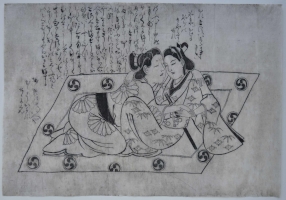
Click here to view image full size.
A large, 11.5 x 16.75 in; 29.25 x 42.5 cms, sumi print showing a courtesan with her client. These are the earliest known ukiyo-e prints with no known book, painting or print being signed. The nomenclature was given by Dr. Richard Lane because the artist worked almost entirely during the Kanbun Period (1661-1673). There is some debate as to whether all the books and prints are by the same hand, rather than by several or more individuals. However, Dr. Lane – who was the pre-eminent authority on shunga – saw a consistency in the style of drawing. Extremely rare.
Very good impression. Some slight soil, but in remarkably good condition given the date.
Status: Sold
Sugimura JIHEI (Acitive c. 1681-1703)

Click here to view image full size.
A shunga print showing a samurai (his swords lying outside the screen) having sexual intercourse with a courtesan from a set of twelve such prints published mid 1680s. Jihei was the most impressive of Moronobu’s followers and seems to have specialised in shunga, often surpassing Moronobu. (Indeed, Jihei’s work was attributed to Moronobu for a long time.) Hand coloured, although probably not from the period but still with considerable age. Extremely rare.
Fine impression. Very good condition.
Status: Sold
Suzuki HARUNOBU (1724-1770)

Click here to view image full size.
A chuban shunga print showing a fisherman taking advantage of a young girl on a boat on the Sumida River. The couple are hidden behind a four-armed scoop-net called a yotsude-ami which was used to catch whitebait in the spring. The British Museum copy (OA+,O.125) gives the location as most probably being at Mitsumata, between Eitai and Shin’o bridges, based on what looks like Lord Tayasu’s residence in the background. Another impression is illustrated in Shunga, Marco Fagioli, Octavo, 1997, no. 23, p.45. Published late 1760s. Rare.
Very good impression. Some slight fading, otherwise good condition.
Status: Sold
Hishikawa MORONOBU (c. 1618-1694)

Click here to view image full size.
The father of Ukiyo-e and the first to design single-sheet prints. Illustrated numerous books and produced a considerable number of paintings. A good proportion of his output was in the form of shunga. The print here is, arguably, from his finest shunga album. A set of 12 prints, although it is known in two versions with two alternative designs making a total of 14 sheets. For one complete set see Shunga The Art Of Love In Japan, Tom and Mary Evans, Paddington Press, 1975, Illus. 5.10-5,21. Rare.
Very good impression. Original hand-colouring. Minor marks and signs of mounting au verso, but otherwise very good condition.
Status: Sold
Katsushika HOKUSAI (1760-1849)
Click here to view image full size.
One sheet from a shunga set of 12 prints Ehon tsuhi no hinagata, “Patterns of Loving Couples.” Published 1814. The series title is a play on words. Tsuhi can be read as “couple” or “male and female pairs” or it can be pronounced tsubi, an old term for vulva.
Very good impression and colour. Slight soil and the usual slight centre fold, otherwise very good condition.
Status: Sold
Okumura MASANOBU (1686-1764)
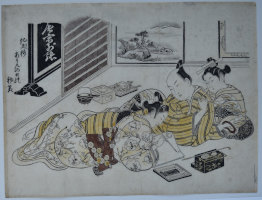
Click here to view image full size.
Shogatsu, “First Month” from a shunga set Someiro no yama neya no hinagata, “Mountains of Dyed Colours, Examples for the Bedroom.” Shows a New Year scene with the master of an opulent household enjoying the holiday with his wife and a young man of his fancy. The poem alludes to the pleasures of both male-male and male-female sex. Published c 1740. Others from the set are illustrated in Tim Clark, Shunga:Sex and Pleasure in Japanese Art, BM, 2013, pp. 147-151. Masanobu is one of the most important figures in Ukiyo-e being the proprietor of a shop but also a publisher, an illustrator of books, print publisher, painter, and inventor of the hashira-e and uki-e as well as being at the forefront of advancements in colour printing. Rare.
Fine impression. Hand colouring, slightly faded. Minor backed wormage, but otherwise very good condition given the date.
Status: Sold
Attributed to Torii KIYONOBU II (Active 1710s – 1760)
Click here to view image full size.
A sumizuri-e abuna-e sheet from a shunga set published c. late 1710s. MFA has 10 sheets from the set , RES.09.310.1 to .10. They are based on designs by his father, Torii Kiyonobu I.
Fine impression. Fine hand-colouring. Backed (from a scroll), some light soil and minor creasing, all appropriate with date.
Status: Sold
Katsushika HOKUSAI (1760-1849)
Click here to view image full size.
One sheet from a shunga set of 12 prints Ehon tsuhi no hinagata, “Patterns of Loving Couples.” Published 1814. The series title is a play on words. Tsuhi can be read as “couple” or “male and female pairs” or it can be pronounced tsubi, an old term for vulva.
Very good impression and colour. Slight soil and the usual slight centre fold, otherwise very good condition.
Status: Sold
Keisai EISEN (1790-1848)
Click here to view image full size.
A pair of lovers from the set Keisei higo “The Secret Language of Courtesans.” This fine set of abuna-e (shunga prints that omit any explicit sex – quite literally “risky pictures”) was privately published c 1822-5. The pre-coital coupling is indicated by the wad of tissue slipped into her obi.
Fine impression and colour. Very good condition. This set employs brass into the printing which is often the cause of the paper degrading and falling out. (Not evident here.) Unsigned as always.
Status: Sold
